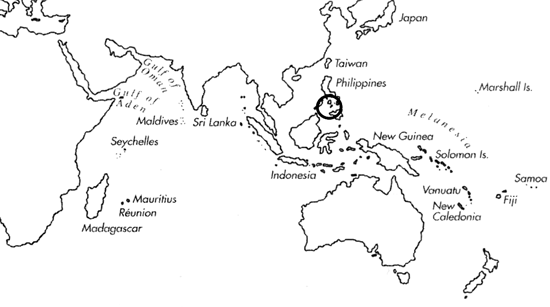Range: Philippines; Mindoro Strait eastward to Sorsogon and southward to Sulu Archipelago.
Description: Medium-sized to large, moderately solid to moderately heavy. Last whorl conical, sometimes narrowly conical; outline variably convex at adapical fourth, straight below, sometimes concave centrally. Shoulder angulate, anal notch very deep. Spire of low to moderate height; outline almost straight with gradually rising whorls, to deeply concave, with a conoid apex projecting from an otherwise nearly flat spire. Larval shell of about 2.25 whorls, maximum diameter 0.8-0.9 mm. First 3-5 postnuclear whorls weakly tuberculate. Teleoconch sutural ramps flat to slightly concave, with a few weak to obsolete spiral grooves on middle ramps. Last whorl with weak spiral ribs at base.
| Shell Morphometry | ||
|---|---|---|
| L | 45-115 mm | |
| RW | 0.20-0.95 g/mm | |
| (L 45-105 mm) | ||
| RD | 0.47-0.63 | |
| PMD | 0.87-0.97 | |
| RSH | 0.02-0.15 | |
Ground colour white to pinkish cream, sometimes suffused with blue in specimens with dark patterns. Last whorl with a generally reticulate but highly variable pattern of yellowish to blackish brown. Colour pattern variants can be grouped into 2 main types: Type I (Pl. 35, Figs. 15, 17): Brown to blackish brown lines and triangular spots form an irregular coarse to fine and variably complete network, varying from heavily developed to isolated lines and spots. Spiral rows of similarly coloured dots and dashes may be present but vary in number and arrangement. Pattern elements may be concentrated in 2 spiral bands, above and below centre. Base white with overlying network, to solid bluish or blackish brown. Type II (Pl. 35, Figs. 14, 16, 18-21): Shells with complete orange or yellowish brown network intergrade with shells with scattered axial lines and few to numerous spiral rows of dots. Pattern often concentrated in spiral bands; variably numerous yellow to light brown spiral lines and bands may also be present. In some specimens, reticulate pattern replaced by streaks, clouds and patches, either forming a coarse meshwork or fusing into confluent spiral zones. Base yellowish brown to dark bluish brown. Pl. 35, Fig. 18 shows a shell intermediate between these two types. Larval whorls white to brown. Postnuclear sutural ramps with scattered to numerous radial lines, streaks or blotches. Aperture white to bluish white or cream, varying within a population.
Periostracum olive, thin, translucent, and smooth except for radial ridges on sutural ramps.
Habitat and Habits: Shallow water. Egg diameter of 602 ┬Ám suggests benthic development ( Perron & Kohn, 1985).
Discussion: C. thalassiarchus resembles C. thomae and some shells of C. amadis. C. thomae can be distinguished by its less deep anal notch, coarser spire pattern of large blotches, and by the primarily spiral arrangement of its last whorl pattern that has only sparse reticulated lines and no axial lines. Its last whorl is often narrower (RD 0.49-0.54). Its spire consistently has gradually rising whorls, a straight outline, and it may be stepped, while the spire of C. rhalassiarchus predominantly has a projecting apex and a concave outline and is not stepped. The periostracum is distinctly thinner and more translucent in C. thomae. C. amadis has a generally broader and more ventricose last whorl, its spire is higher and has gradually rising whorls, and its sutural ramps bear distinct spiral grooves. C. thalassiarchus exhibits a considerable variation in colour pattern that can be to some extent associated with the geographical occurrence: Shells of pattern Type I are known from the north-eastern parts of the range (Sorsogon to northern Cebu) and in Palawan (S.W. Philippines), while those of Type II occur from the north-western part (Coron) through Cuyo Is. to Cebu and further south to Zarnboanga and the Sulu Archipelago (S.E. Philippines). In particular, streaked and clouded yellowish to orangish brown shells occur in the south-eastern part of Philippines. C. castrensis is based on a dark-patterned shell without spiral bands (Type I); the holotype of C. mariei (Pl. 35, Fig. 14) represents Type II, with reticulated white spiral bands, below shoulder and at centre, and solid yellowish brown bands above and below centre. The forms described by Wils as well as form ikatt fall within the range of the general pattern type associated with their localities.

C. thalassiarchus Range Map
This section contains verbatim reproductions of the accounts of 316 species of Conus from the Indo-Pacific region, from Manual of the Living Conidae, by R÷ckel, Korn and Kohn (1995). They are reproduced with the kind permission of the present publisher, Conchbooks.
All plates and figures referred to in the text are also in R÷ckel, Korn & Kohn, 1995. Manual of the Living Conidae Vol. 1: Indo-Pacific Region.
The range maps have been modified so that each species account has it own map, rather than one map that showed the ranges of several species in the original work. This was necessary because each species account is on a separate page on the website and not confined to the order of accounts in the book.